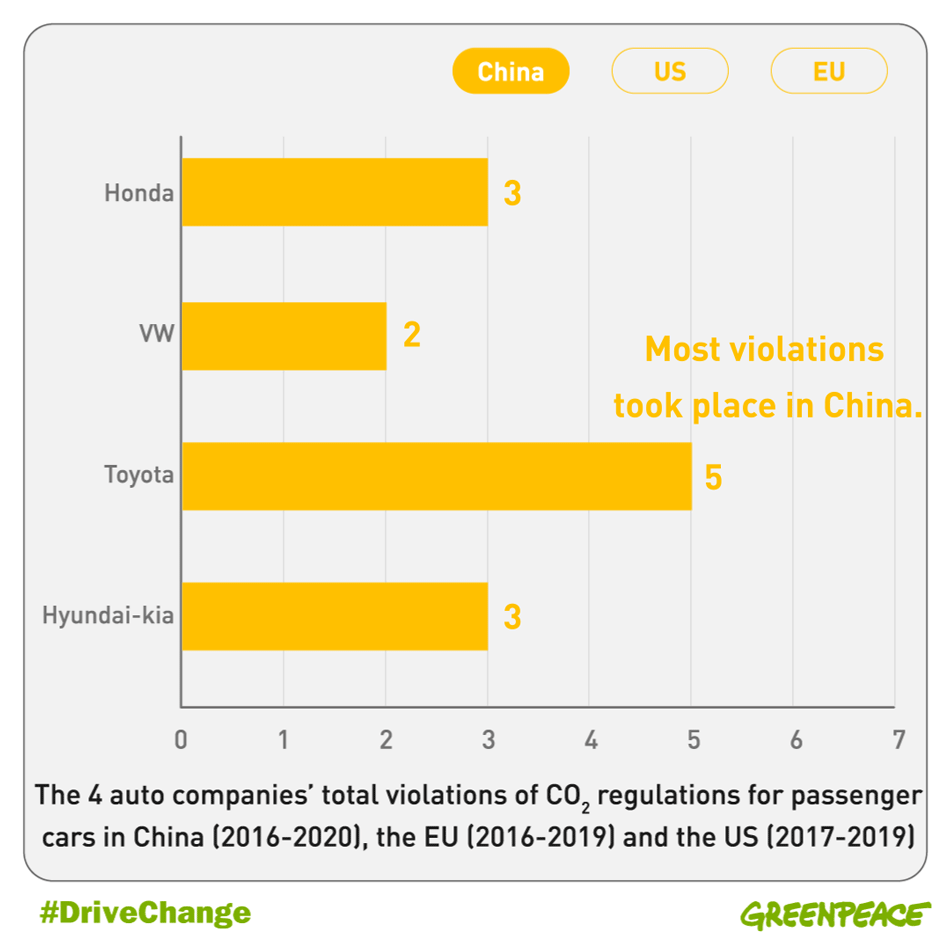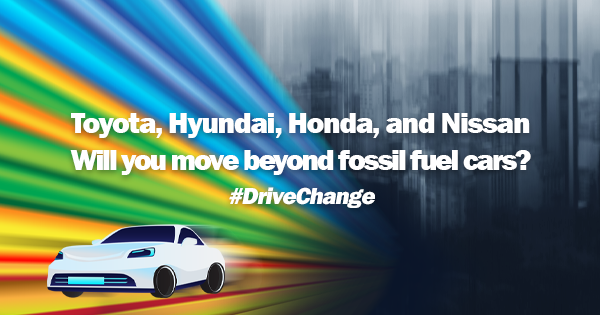The transportation industry makes up about 16% of all global CO2 emissions. That’s a huge contribution for a single sector and therefore a smart target to push to go carbon zero as soon as possible.
There are two easy and obvious ways for the passenger car industry, a huge part of the transportation sector, to play its part, and that’s to stop making fossil fuel cars by 2030 and to ensure it’s using the highest standards and adopting the best available fuel-efficient technologies so that carbon emissions for all their vehicles are as low as possible and as soon as possible.
Automakers have told the world they are committed to going carbon neutral, but our research shows the other side of the story.
Greenpeace looked at four of the world’s best-selling brands — Volkswagen, Toyota, Hyundai-Kia and Honda — and how they were doing on complying with CO2 regulations in China (2016-2020), the EU (2016-2019) and the US (2017-2019).
This is what we found with the major automakers from East Asia:
- Across the board, they repeatedly failed carbon emissions standards.
- They did markedly worse in those markets that had weaker regulations, showing huge double standards in their climate change commitments.
- The lion’s share of violations occurred in China, where regulations are not well enforced.
Toyota, one of the biggest and best-known brands in the world, did particularly badly.
It repeatedly failed China’s fuel consumption standards between 2017 and 2019 but met standards in the EU and the US over the same time period. Even taking into account that China’s emission standards are not as rigorous as that of the EU, the average annual CO2 emissions from Toyota’s major joint venture in China was on average more than 30% higher than emissions from Toyota’s cars in the EU from 2017 to 2019.
If they can do it in the US and EU, why can’t they do it in China? The climate crisis does not recognise borders so it makes no sense for a carmaker to have different climate change policies in different markets.
Hyundai-Kia, in some ways, did even worse.
They failed to meet CO2 standards in China and the US six times from 2017-2020, that’s the highest failure rate of all four carmakers. In the EU, where standards are stricter, the company showed it was able to rapidly improve performance. According to the data from International Council on Clean Transportation (ICCT), we estimate that Hyundai and Kia’s average CO2 emissions dropped by around 25% and 24%, respectively, from 2019 to 2020 in Europe. But this only happened in the EU.
Just this year, Hyundai announced it would go carbon neutral in 2045, and that it would phase out fossil fuel cars by 2040. But there are double standards at play here too because these measures only apply in the China, EU and US markets. It has no such plans for its home base South Korea nor India, where it has a sizable market share. It is obvious that Hyundai is not a market leader for consistent environmental action.

All the carmakers performed abysmally in China.
After 2016, most of the carmakers’ joint ventures failed to keep pace with China’s fuel consumption standards even though they had the technology to do so and were using it in the EU.
Carmakers’ major joint ventures in China produced average annual CO2 emissions that were substantially higher than those same carmakers recorded in the EU and the US from 2017 to 2019.
Because China does not impose financial penalties for non-compliance, these companies consistently flout regulations, showing that standards must have teeth to work. Another issue in China is the growing popularity of heavy and large-sized cars like SUVs, that are not fuel-efficient.

What this all means
Clearly, the car industry is not honouring its promise to go carbon zero fast enough. It is not using the best standards and technologies in all markets; it is doing just enough to comply with local regulations, and in some cases, not even good enough for those.
It really should be doing the best it can in all markets, and not just in the EU where rules are tougher.
It is a great shame and also dangerous that these household names are not shouldering their responsibility to us nor honouring promises in the race to go carbon zero in all markets.
But since the car giants won’t act by themselves, then regulations that are strictly enforced are a good motivation to get them to improve their carbon performance.
What can carmakers do to show their leadership to drive change?
To really show their leadership in cutting carbon emissions to save our climate, carmakers must use the best available technologies to go clean and meet strict carbon emission standards in every market while moving away as fast as they can from fossil fuel vehicles.
At the same time, we want policymakers to keep tightening emissions standards and impose higher penalties for non-compliance because we know this works.
And at the individual level, of course, we’d love more people to walk, cycle, and take public transport! And for this to happen, governments around the world need to improve infrastructure to make public foot-powered transport easier and safer for everyone.
Read the full report:
Join our #DriveChange campaign to get major car companies on track to achieve zero carbon emissions for ourselves, our future, and our planet!

